The Great Western Railway opened Southall station on 1 May 1839, nearly one year after it opened its first broad gauge line on 4 June 1838, between London Paddington and Maidenhead Bridge (the latter now known as Taplow). As built, the station had two platforms with the main station building in the centre of the up platform reached from a forecourt, with a smaller building opposite on the down platform. During the construction of the Brentford branch the station was enlarged with a bay being added on the down side for Brentford trains. There was a modest goods yard on the down side accessed from the station forecourt with two sidings, one of which passed through a goods shed.
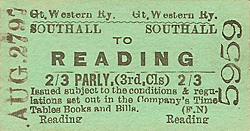 |
In 1861 the line between Paddington and Reading was converted to mixed gauge. During 1876 the station was completely rebuilt with a pair of standard gauge relief lines being added on the north side of the formation. Two new island platforms and a side platform on the north side were provided, with Brentford branch trains using the most southerly island face. The original |
station building was demolished and replaced with a new building on the road bridge, straddling the lines. The single-storey structure was distinguished by three flat-topped French pavilion roofs, each with iron trellis-work decorating them. Covered stairways led down to the three platforms. Each platform was provided with buildings and a canopy. The southern island had a ridged canopy, the middle island had a hipped canopy and the northern platform had a flat canopy.
Southall East Station signal box stood at the London end of this platform, and Southall West Station box was to the west of the road bridge between the main line and the Brentford line. There were also boxes at Southall West Junction and Southall East Junction. All four boxes opened in 1899 and closed 11 May 1968. The goods yard was also expanded with one siding being extended to the west, almost to South Road, and another siding being built parallel to it. By the turn of the century the yard had been expanded again with the siding running through the goods shed extended to the west to serve a long loading dock. Another parallel siding was also added to the south, serving an outer face of the northern passenger platform which could be used as a dock or could also be used by terminating passenger trains. The yard handled a full range of goods traffic including livestock, and it had a 3-ton crane. A private siding served the Brentford Gas Company’s works.
From 1 March 1883 to 30 September 1885 (when the service was discontinued as uneconomic) the Metropolitan District Railway ran trains between Mansion House and Windsor which called at the station.
Otto Monsted, a Danish margarine manufacturer, built a large factory at Southall in 1894. The factory was called the Maypole Dairy, and eventually grew to become one of the largest margarine manufacturing plants in the world, occupying a 69 acre site at its peak. The factory which was on the south side of Southall station also had its own railway sidings with a large railway warehouse and branch canal. The Maypole Dairy Company was later acquired by Lever Brothers who, as part of the multinational Unilever company, converted the site to a Wall's Sausages factory which produced sausages and other meat products until the late 1970s.
A single-road engine shed stood between the main line and the branch line at the east end of the station. This was opened by the Great Western & Brentford Railway in July 1859 and was known as the Brentford Branch shed. It was of brick construction with a gabled roof and a 40ft turntable on the approach road. Once the Brentford branch passed to the GWR, the original shed was considered inadequate and plans were drawn up for a new 6-road shed in July 1883. The original shed closed in 1884 with the new shed coming into use in June that year. The shed was of brick construction with a north-light roof and a 45ft turntable at the rear. An extension on the north wall housed offices and a repair shop. A corrugated iron shed, specifically for rail-motors, was opened on the south side of the diverging branch on 28 September 1904. This closed 1953 and was demolished c1960.
| During WW2 the main shed was damaged by bombing and re-roofed c1943. This shed was substantially rebuilt in 1953/4; it still had six roads, but the repair shop alongside was replaced with a 2-road diesel depot; this comprised a steel frame on a brick base. A new repair shop was provided to the east. The coaling stage to the west of the shed was replaced during the |
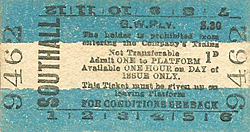 |
BR rebuild when a mechanical device was provided but the water tank on top remained in use. At this time the shed code was 81C. The shed closed to steam on 3 January 1966 and had the distinction of being the last BR Western Region depot in London with an allocation of steam locomotives. It was then used for DMUs until November 1986. From 1993 to 1998, it was used as a base for the electrification programme for the Heathrow Express. .
Currently the site, now referred to as the Southall Railway Centre, is used by three independent groups, including Locomotive Services (where volunteers can contribute to the preservation and restoration of main line locomotives) and the Great Western Railway Preservation Group. In the 1980s the GWRPG ran two one-day shuttle services between Southall and the former Brentford Town goods depot; these were on 28 August 1983 and 15 July 1984. Rather than use the former Brentford branch platform at Southall, a temporary scaffolding platform was constructed opposite the station. It was very narrow, and passengers boarded and alighted through the guard's door of a single-car DMU. This DMU has now been sold and no further shuttles are planned, but the group is in negotiations with Network Rail about operating a steam service at some time in the future.
During the 1960s the roads between the depot and the Brentford branch were used for storing steam locomotives awaiting scrapping. The goods yard closed on 3 January 1967 although private sidings remained in use after that date.
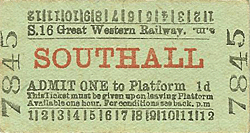 |
Southall railway station has five platforms, one of which is un-numbered and used only for freight and special events. Access to all platforms is by stairs from South Road. In normal circumstances platforms 1 and 2, on the fast lines, and the un-numbered platform are not used by passengers; platforms 3 and 4 are used by all trains serving the station. The station building, was |
shortened c1980s so that only two of the three French pavilion roofs remain, no longer carrying their attractive ironwork. The building is now only above the fast lines, and it contains a booking office and a newsagent's shop. A footbridge gives access to platforms 3 and 4, while a gate prevents access to the other three, under normal circumstances. Although the passenger service on the Brentford branch was withdrawn in 1942 station nameboards still showed the suffix 'Brentford Junction' until the mid 1950s.
Southall station is due to be rebuilt again as part of Crossrail to provide increased capacity and improved facilities, along with the provision of a new footbridge providing step-free access to the platforms. Platform extensions will be undertaken and new platform canopies may be provided. Click here for full details.
Passenger services are currently provided by First Great Western from London Paddington to Reading, Oxford and Newbury, and by Heathrow Connect from Paddington to Heathrow Airport.Southall is one of three stations in England which have bilingual station signage, the others being Wallsend, on the Tyne and Wear Metro (which has signs in Latin), and St Pancras International (French). Station signs on the platforms bear 'Southall' and also ' ਸਾਊਥਹ'ਲ" in Gurmukhī, a script commonly used for Punjabi. In addition, some station information notices have also been provided in Punjabi, because many Punjabi-speaking people live in the station's catchment area.
BRIEF HISTORY OF THE GWR BRENTFORD BRANCH
In the years following the opening of the Great Western Railway's main line from Paddington to the West Country, a number of short branch lines were built in order to connect nearby towns to
the main line which had by-passed them. In general, the motivation to build these lines came both
from the inhabitants of the towns who wanted to benefit from the advantages of rail transport,
and the GWR itself, which was naturally interested in generating additional trade. However, in the case of the Great Western and Brentford Railway, the motivation came almost wholly from the GWR.
| For some time the GWR had been anxious to obtain a broad gauge outlet to the Thames as near to London as possible, allowing the company to reach the inner London docks; Brentford was finally chosen as the most suitable location. It is situated at a point where the GWR main line is nearest to the navigable Thames and is also the southern terminus of the Grand Junction |
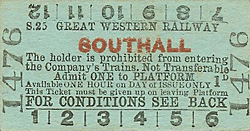 |
(now Grand Union) Canal. The GWR proposed the construction of a dock and a broad gauge branch line, four miles in length, which would connect with the main line at Southall.
Support for the scheme from the people of Brentford was somewhat muted as they had already been placed on the railway map in 1849 with the opening of the Hounslow Loop by the London & South Western Railway, and this line gave direct access to London. However it was recognised that the proposed dock would bring some further employment to the town.
Consequently, on 14 August 1855 the Great Western & Brentford (Thames Junction) Railway was incorporated. Initially there was some opposition, notably from the Grand Junction Canal Company and the Duke of Northumberland, owner of nearby Syon House. The company had been promoted by the GWR which had subscribed most of the capital required and piloted the Bill through parliament.
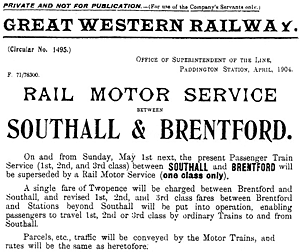 |
Brunel was appointed chief engineer, and he estimated that the cost of the entire project, including the dock, would be £100,000, although once construction was under way he quickly revised this upwards. This was to be Brunel's last railway project as he died two years after the line opened. The connection with the main line was to be by means of a west-facing junction which would allow through running of freight trains to and from all parts of the system, for freight traffic was to be the life-blood of the branch. However a passenger service was also projected and a |
separate platform was set aside at Southall station specifically for this purpose.
The objections to the scheme were quickly resolved, and work was able to start in the spring of 1856 with Thomas Treadwell appointed as contractor. Construction of the railway took four years to complete, the delay being mainly due to the need to build a unique three-level bridge where the railway passed under both the Grand Junction canal and Windmill Lane, the road from Southall to Heston. Considerable trouble was experienced at this point with flooding from the canal.
| During the construction the local company was responsible for any disruption to canal traffic, with a fine of £10 per hour being imposed if there was any suspension of navigation. The approach to Brentford was on an embankment, and a bridge was built to carry the line over Brentford High Street. In later years, with the building of the new Great West Road which |
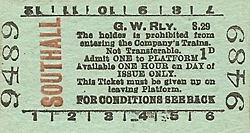 |
by-passes Brentford, a single-span girder bridge was also built where the road passes under the railway. The line was laid to broad gauge and was single-track throughout although the formation was of sufficient width to take a second track if that was required at a later date.
The line was officially opened on 15 July 1859 when railway officials and invited guests arrived by paddle steamer from London Bridge for the special ceremony and celebration dinner after a return trip to Southall. Freight services began on 18 July 1859 and were worked by the GWR to whom the line had been leased.
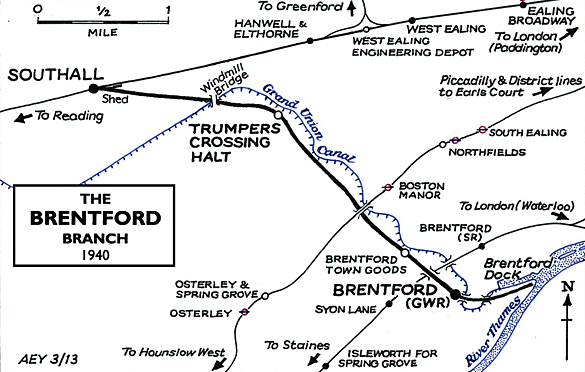 |
Prior to opening to passengers, the line had to pass a Board of Trade inspection which took place on 5 September 1859. In his report, Col Yolland stated that the line was ‘not yet ready for public use’, citing a long list of remedial work that must be completed before the line could open. A further inspection was made on 17 September but Col Yolland still refused to sanction the opening of the branch. There is no record of a further inspection but passenger services commenced without ceremony on 1 May 1860. There were two stations at Brentford: one to serve the town which would be the terminus for normal service trains, and a second station in the dock to be used by excursions connecting with the ferry to Kew Gardens. Although built there is no record of this second station ever being used.
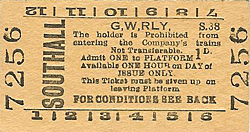 |
The freight traffic materialised as expected with 58,000 tons of goods and minerals being carried in the first six months; within a year this had increased to 66,000 tons, and traffic continued to grow. In 1861, following the laying of mixed gauge on the main line, a standard gauge line was laid alongside the broad gauge line on the branch; the broad gauge track was used by |
passenger trains while the standard gauge line was used for goods traffic. At this time, there were several schemes to extend the line, one of which would have taken it over the river to Twickenham; nothing got beyond the planning stage.
Following a number of disputes between the local company and the GWR the directors eventually sold out to the GWR on 1 January 1872. In June 1875 the broad gauge track was converted to standard gauge and the branch was then worked as a conventional double-track branch.
| Although the volume of freight traffic continued to increase steadily through the years, the passenger traffic remained at a disappointingly low level. The branch ran through largely undeveloped countryside and the west facing junction made it impossible to run through services into Paddington. Despite this, the 1902 timetable showed a surprisingly frequent nine |
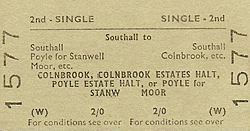 |
trains each way on weekdays and seven on Sundays. In an attempt to generate more passenger traffic steam-hauled trains were replaced with steam rail-motors on 2 May 1904. At the same time Trumpers Crossing Halt opened at about the halfway point on the line; it served the Wyke Green golf club and the residential outskirts of Hanwell.
Despite a half-hourly service of rail-motors running seven days a week, passenger numbers were still generally disappointing although on occasions there were too many passengers for the single-car rail-motors, and a trailer had to be added. These proved too heavy and, after a year, push-pull auto-trains began operating the service.
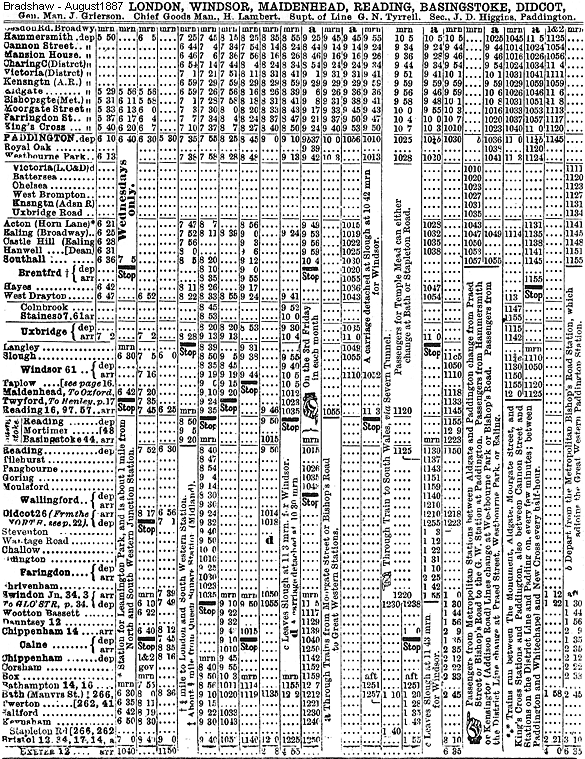 |
On 26 May 1906 electric trams began operating between Brentford and Hanwell and these were quick to take their toll on the Brentford branch. The passenger service was withdrawn as an economy measure during WW1 and was reinstated following local pressure on 12 April 1920, but only on weekdays. The Sunday service was reinstated in 1923 but lasted for only a few weeks. Trumpers Crossing Halt closed permanently on 1 February 1926. Passenger numbers continued to decline with the growth of road passenger transport in the locality, and in 1929 the service was reduced to Monday - Friday rush hours, with services on Saturday running in the early morning and around midday. This infrequent service of auto-trains was finally withdrawn on 4 May 1942. The greatest obstacle to the development of local passenger trade had been the west-facing connection at Southall which prevented through running to and from London. However even had this been possible it is questionable whether the volume would have ever become substantial as the journey would have been somewhat circuitous in comparison with the LSWR route to Waterloo.
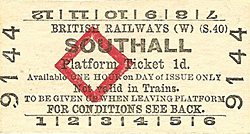 |
Despite closure to passengers the freight business continued to grow, with traffic using not only Brentford Docks but also the Brentford Town goods yard which had opened on 3 November 1930 to serve local factories, some of which had private sidings. It was sited on the north side of the new Great West Road, nearly half-a-mile north of the passenger station. By |
1951 there were 25 goods trains a day but, despite this, single-line working was introduced in 1952 using the former up line. This was reversed in July 1956 and the former up line was lifted. By 1956 the annual tonnage of goods and minerals had grown to about half-a-million tons and was being handled by the docks and the goods yard in equal volume.
As the 1950s drew to a close, freight traffic was beginning to switch to road haulage. The early 1960s brought new forms of goods handling in the London docks, in particular containerisation; the outdated facilities at Brentford left little scope for competition. It was decided to close the docks in 1964 following the collapse of a crane. The cost of replacement was such hat it became more economical to transfer the traffic to alternative docks; on 31 December 1964 the service ceased and the track was lifted six months later.
It must be borne in mind that after conversion of the GWR to standard gauge, it would have been a practical possibility for the company to obtain an outlet to the Thames in the main London docks at any time. This would have been simpler still after nationalisation in 1948, which removed the need to obtain running powers over other companies' lines. After all, the reason for building the Brentford branch in the first place was the restriction caused by broad gauge.
| Through the 1960s the local factories which had been the mainstay of the goods yard had been steadily transferring their freight to road transport, and there was a general decline in the volume of rail traffic. Brentford Town goods station closed on 7 December 1970 although some private sidings remained open. Eventually all that remained of the original traffic which |
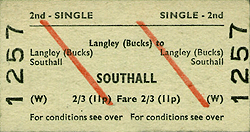 |
used to pass through Brentford goods yard was an occasional coal train, stone and scrap metal; the large goods shed remained empty and unused. In May 1976 the GLC signed a 30-year contract with British Rail to use the branch for the transport of rubbish. The following year, a solid waste transfer station was opened on the site of the former Brentford Town goods yard. Special container wagons were loaded at Brentford from where they were transported to a tip at Didcot for emptying. In 1993 there were six workings over the line each week.
The transfer station currently handles 158,000 tonnes of waste each year. The waste is delivered by the London Boroughs of Richmond, Hounslow and Ealing. It is then loaded onto trains which currently leave the site up to four times a week transporting rubbish to a landfill site in Oxfordshire for disposal. It is one of only three transfer stations in London with a rail siding to allow waste to be taken away.
Tickets from Michael Stewart, route map drawn by Alan Young, Bradshaw from Chris Totty
Click here to see a video of the Concrete Cow railtour which visited the Brentford branch on 28 January 2012.
Click here for a video of the aggregate terminal on the Brentford branch made by the GWR Preservation Group
Sources:
- British Branch Lines No 9 - The Great Western & Brentford Railway by KW Whittaker (magazine article)
- The Brentford Branch by JE Connor - article in London Railway Record No. 17 October 1998 (Connor & Butler)
To see other stations on the Brentford branch click on the station name:
Trumpers Crossing Halt, Brentford Town (Goods), Brentford & Brentford Dock
See also special feature Windmill Lane Bridge (Three Bridges) |

old11.jpg)

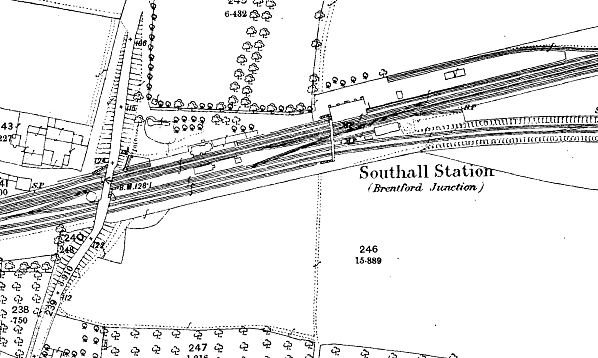
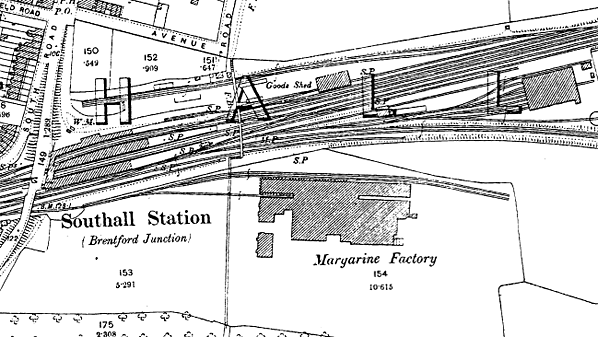
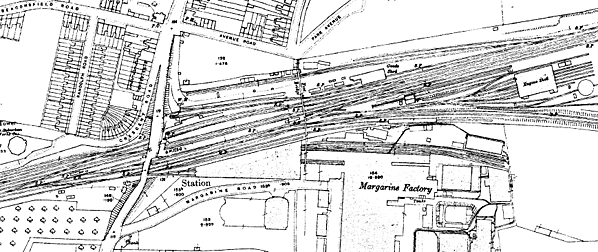
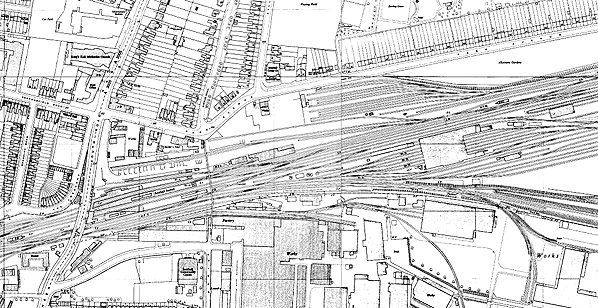
old2.jpg)
old5.jpg)
old7.jpg)
old4.jpg)
old13.jpg)
old1.jpg)
old10.jpg)













old17.jpg) Looking east along the Brentford branch from the footbridge linking Bridge Road and Park Avenue in August 1919. Southall motive power depot is seen straight ahead. The curved roof of the 1904 rail-motor shed can just be made out behind the signal. The buildings on the right are part of the Mayfield Dairy. The tall tower is a water softener. There is also a water tank on a brick plinth, partly obscured by the telegraph pole.
Looking east along the Brentford branch from the footbridge linking Bridge Road and Park Avenue in August 1919. Southall motive power depot is seen straight ahead. The curved roof of the 1904 rail-motor shed can just be made out behind the signal. The buildings on the right are part of the Mayfield Dairy. The tall tower is a water softener. There is also a water tank on a brick plinth, partly obscured by the telegraph pole.
 Home Page
Home Page